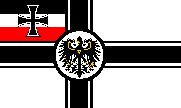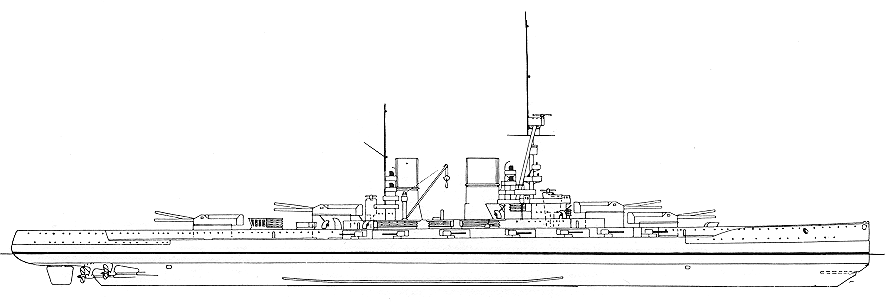
GROßE KRUEZER
The Next Generation - Mackensen, Graf Spee, Prinz Eitel Friedrich, and Ersatz "A"

Finally able to get around the Kaiser's fondness for the 11" gun and recognizing the need to match the heavier armaments mounted on British capital ships, designers for the German Navy (the K-RMA) took the Derfflinger design and modified it slightly in width and length to accommodate the newly developed 380mm/45 caliber twin turret. And for the first time since Von der Tann, the rudders were placed in the more commonplace side-by-side, or dual, configuration.
Armor protection was again heavier than her British contemporaries, but Mackensen still would have made 28 knots using 90,000 horsepower. To compensate for the additional topside weight of the larger turrets, the casement guns were placed one deck lower than on Derfflinger.
Though Mackensen and Graf Spee were launched, little or no work was done on any of the ships after 1917 due to a lack of material and manpower. The Allies, not knowing this, listed Mackensen as one of the ships to be interned on November 21, 1918. In its place the SMS Baden, the fleet flagship, was sent in its place and was lost with the rest of the fleet at Scapa Flow. In 1920 Prinz Eitel Friedrich was launched to clear the building ways. All the ships were quickly scrapped after the war.
The Mackensen class was originally set to be seven strong, but the last three ships were redesigned prior to being laid down and are commonly considered the Ersatz Yorck class.
PHOTOS
Mackensen
 Mackensen - Line Drawing - Side Views (Gröner)
Mackensen - Line Drawing - Side Views (Gröner)
 Mackensen - Line Drawing - Top and Side Views (Gröner)
Mackensen - Line Drawing - Top and Side Views (Gröner)
 Mackensen - Line Drawing showing armor thickness
Mackensen - Line Drawing showing armor thickness
 Mackensen under construction
Mackensen under construction
 Mackensen - Starboard Bow Aspect at launch - April 17, 1917
Mackensen - Starboard Bow Aspect at launch - April 17, 1917
 Mackensen - Port Aspect at launch - April 17, 1917
Mackensen - Port Aspect at launch - April 17, 1917
 Mackensen (L) and Graf Spee (R) either fitting out or awaiting scrapping
Mackensen (L) and Graf Spee (R) either fitting out or awaiting scrapping
Graf Spee
 Graf Spee - Port Bow Aspect at launch - September 15, 1917
Graf Spee - Port Bow Aspect at launch - September 15, 1917
 Graf Spee - Port Aspect at launch - September 15, 1917
Graf Spee - Port Aspect at launch - September 15, 1917
 Mackensen (L) and Graf Spee (R) either fitting out or awaiting scrapping
Mackensen (L) and Graf Spee (R) either fitting out or awaiting scrapping
Prinz Eitel Friedrich (proposed name for "Ersatz Freya")
 The hull of Prinz Eitel Friedrich lies inboard of the incomplete
Bayern-class battleship Württenburg (probably in Hamburg prior to their scrapping in 1921)
The hull of Prinz Eitel Friedrich lies inboard of the incomplete
Bayern-class battleship Württenburg (probably in Hamburg prior to their scrapping in 1921)
Ersatz A (possibly to be named "Fürst Bismarck")
Never launched
SPECIFICATIONS
Project Name: Heavy Cruiser Ersatz Victoria Louise (Mackensen) | Ersatz Blücher (Graf Spee) | Ersatz Freya (Prinz Eitel Friedrich) | Ersatz Friedrich Carl and later Ersatz A (Possibly to be named "Fürst Bismarck")
Builder: Blohm & Voss, Hamburg | F Schicham, Danzig | Blohm & Voss, Hamburg | Imperial Dockyard, Wilhelmshaven
Laid Down: January 30, 1915 | November 30, 1915 | May 1, 1915 | November 3, 1915
Launched: April 21, 1917 | September 15, 1917 | March 13, 1920 | Never Launched
Commissioned: None were completed
Sunk: None were completed
Scrapped: Mackensen - Scrapped 1922 | Graf Spee - Scrapped 1921 - 1922 | Prinz Eitel Friedrich - Scrapped 1921 | Ersatz A - Broken up on building ways 1922
Displacement: 31,000 tonnes (designed) / 35,300 tonnes (maximum)
Dimensions (meters): 223.0 (overall) x 30.4 x 9.3
Dimensions (feet): 735.9 (overall) x 100.32 x 30.69
# of Shafts/Propellers: 4
# of Propeller Blades: 3 (4.2m diameter)
# of Rudders: 2 (dual - one beside the other)
Max Speed/Range: 28.0 kts / 8,000 nm at 14 kts
Main Battery: Eight 350mm (13.8")/45 caliber - 4 dual turrets
Secondary Battery: Fourteen 150mm (5.9")/45 caliber - all single casement mounts
AA Battery: Eight 88mm (3.5")/45 caliber - single mounts
Torpedo Tubes: Five 60cm tubes(all underwater - one bow, one mounted on each side just forward of "Anton" turret, one mounted on each side just aft of "Dora" turret)
Complement: 46 officers and 1140 enlisted (as designed)
LINKS TO OTHER WEB-SITES
Naval Weapons of the World German Naval Guns
Naval Weapons of the World Pre-World War II German Torpedoes
German Kriegsmarine Encyclopedia
Back to Großen Kruezers.
Back to Home.